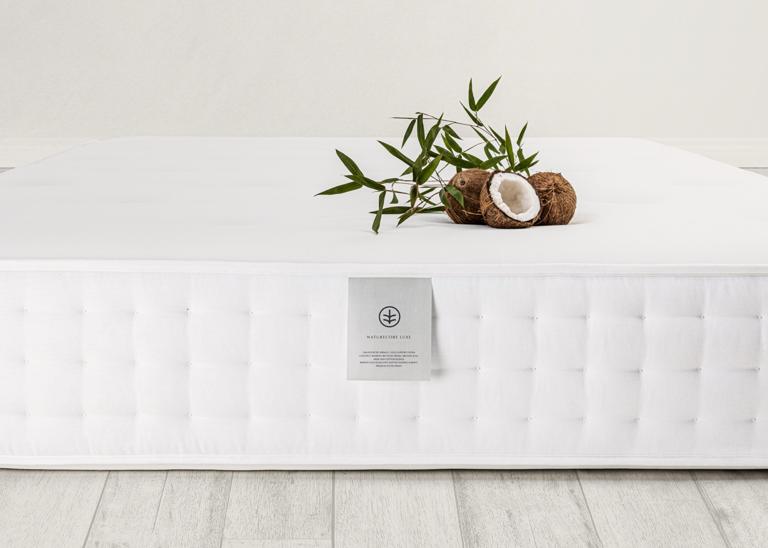Memory foam mattresses are everywhere. They promise contouring comfort, pressure relief, and futuristic sleep technology. But what’s actually inside them?
More importantly - what are you breathing in, sleeping on, and living with for eight hours every night?
In this article, we break down exactly what memory foam is made of, how it behaves over time, and why we believe there are safer, healthier alternatives for you and the planet.
What Is Memory Foam?
Memory foam, also known as viscoelastic polyurethane foam, was originally developed by NASA in the 1960s. It is made by combining petrochemical-based polyols with diisocyanates and adding chemical blowing agents to create an open-cell foam.
This creates a soft, heat-sensitive material that moulds to the shape of your body and returns slowly to its original form.
But that flexibility comes at a cost - both to your health and to the environment.
Key Components of Memory Foam
1. Polyurethane
The base material in memory foam is polyurethane, a plastic derived from petroleum. It is the same material used in car seats, insulation, and packaging.
2. Blowing Agents
Chemical blowing agents are used to create the foamed structure. These can include gases such as carbon dioxide, methylene chloride, or even pentane. Some of these agents are volatile and can release toxic residues into the air.
3. Flame Retardants
To meet fire safety regulations, memory foam mattresses are often treated with chemical flame retardants. Common compounds include TDCPP, TCEP, and PBDEs—many of which have been linked to hormonal disruption and long-term health concerns.
4. Additives and Fillers
To control firmness, elasticity, and cost, manufacturers add a range of undisclosed additives. These might include synthetic latex blends, dyes, plasticisers, and adhesives. Rarely are these ingredients listed on product labels.
Off-Gassing: The Hidden Risk
Memory foam is notorious for a process called off-gassing. This refers to the release of volatile organic compounds (VOCs) into the air when a new mattress is unboxed.
VOCs can cause:
• Headaches
• Dizziness
• Eye and throat irritation
• Sleep disturbances
• Worsening of asthma or allergies
The chemical smell may fade after a few days, but emissions can continue at lower levels for months. For sensitive individuals, children, and pets, this exposure can be particularly harmful.
We’ll go deeper into off-gassing and indoor air pollution in a dedicated article.
Environmental Impact
1. Non-Recyclable
Memory foam is extremely difficult to recycle. Most mattresses end up in landfill or incinerators. Because it is made from petroleum-based plastics, it will never biodegrade.
2. High Carbon Footprint
The production of polyurethane foam is energy-intensive and relies on non-renewable fossil fuels. The carbon footprint is significantly higher than that of natural alternatives like coconut coir, bamboo, or hemp.
3. Plastic Waste
When memory foam breaks down, it releases microplastics into the air and environment. Over time, these particles can become airborne and contribute to indoor dust pollution.
Performance Issues
Although marketed as high-tech, memory foam has significant drawbacks in use:
Heat Retention
Memory foam traps heat due to its dense structure. Many users experience hot, sweaty sleep, especially in warmer climates or during summer months.
Sagging and Compression
Over time, memory foam compresses and loses its bounce. It does not recover as effectively as springs or natural fibres, leading to dips and uneven support.
Lack of Responsiveness
Because memory foam reacts slowly, it creates resistance rather than adaptability. This can cause micro-adjustments throughout the night, leading to restless sleep.
What’s the Alternative?
If you want to avoid foam, glues, and synthetic chemicals entirely, the CocoCore mattress is your best option.
CocoCore is made with:
• Coconut coir for structure and airflow
• Zoned pocket springs for full-body support
• Natural bamboo and hemp fibres for hygiene and breathability
• Recycled ocean plastic used only in high-durability, non-contact layers
• Zero foam. Zero glues. Zero off-gassing.
CocoCore vs Memory Foam: A Clear Choice

What to Watch Out For
Memory foam brands often use green-sounding marketing terms to reassure customers, such as:
• “Plant-based foam” (often contains only 5 to 20 percent plant content)
• “CertiPUR-US certified” (only limits, not eliminates, toxic ingredients)
• “Eco” or “green” ranges that still rely on synthetic foam bases
If a mattress contains polyurethane, adhesives, or flame retardants, it is not truly natural - regardless of the branding.
Final Thoughts
A mattress is not just where you sleep. It is where you recover, restore, and spend a third of your life.
Memory foam may be convenient and cheap in the short term, but it comes with long-term trade-offs: for your health, your comfort, and the environment.
The CocoCore mattress was created to be the ethical, breathable, and high-performance alternative. Built for real sleep. Built for a better future.




Share:
Natural Latex vs CocoCore: Which Mattress Is Better?
Eucalyptus Sheets vs Cotton Sheets: Which is Best for You and the Planet?